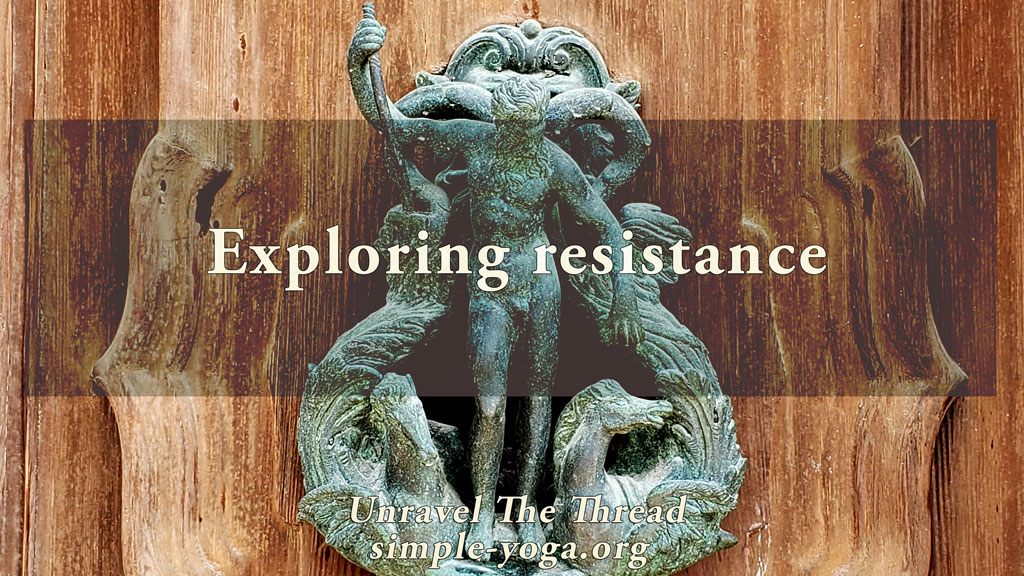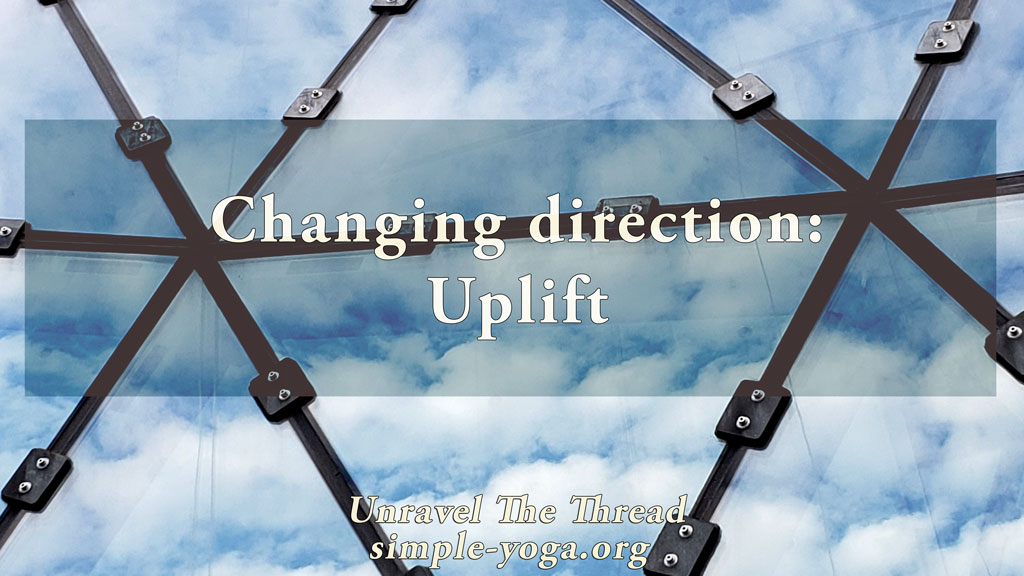
Exploring resistance
February 7, 2024
Complaining
February 25, 2024
Exploring resistance
February 7, 2024
Complaining
February 25, 2024Changing direction – Uplift

Changing direction: Uplift
As we mentioned earlier, Patañjali outlines eight aspects of yoga practice in The Yoga Sutras: the yamas, niyamas, asana, pranayama, pratyahara, dharana, dhyana, and samadhi . Although not mentioned as often as the eight limbs, Patañjali has also given us the gift of a very useful strategy called pratipaksha bhavana, cultivating the opposite, or turning things around. We have mentioned before that when we witness ourselves, we often find some of the tendencies we have cultivated, both consciously and unconsciously, in our posture, movement, thinking, and emotions. As we witness, we can recognize whether the tendencies we notice are helpful or unhelpful. For example, many of us find that our internal narrative or commentary, in addition to ruminations about our sense of self or personal history, may have a tendency toward negativity. It is not that one should never have negative thoughts, but that it is important to notice the effects of frequent negative thinking.
We can try a simple experiment. As usual, find a comfortable position that enables you to be relaxed and attentive. Now let’s see what happens when you choose a negative thought, something small, nothing big or catastrophic. Take this thought and stay with it, swirling it around your inner world. What happens inside of you? Does dwelling on this small negative thought create any sensations, emotions, images or thoughts? How does it make you feel? The next time you exhale, let go of the negative thought. Take several rounds of pleasant inhalations and exhalations… When we fill our inner space with negative thoughts, most of us feel some degree of restriction, irritation, or restlessness. So if this is one of the unhelpful tendencies in us, we can simply try to turn it around. We begin by noticing the tendency. Then we try to notice when we are engaging in the tendency to repeat negative thoughts. Sometimes we don’t even realize we’re doing it until we start to feel some level of irritation or agitation. At that point, we can let go of the thought and take a few deep breaths, paying close attention to the sensations associated with breathing. Remember that as we try to turn a well-established tendency around, the single most important skill to cultivate is the ability to keep returning to the present moment with a gentle smile, without strain, struggle, or self-judgment. So each time we catch ourselves going down the path of negativity, we simply return to being in the present. It does not really matter how many times we return to negativity, the important thing is to notice and let go. Eventually it becomes easier and easier to notice the negativity as it happens, and we may even begin to notice it before it manifests. Then we can consciously choose to engage in the negativity or not. It is still our choice, and we will still receive the effects of engaging in it if that is the path we choose. This is the first approach to Pratipaksha bhavana, noticing and letting go.
This first approach is useful, especially if we find that it grows organically over time. Pratipaksha bhavana can be even more uplifting if we replace the unhelpful tendency with a helpful one. In other words, instead of just trying to curb the negative tendency, we proactively choose to establish a beneficial attitude. In the example of noticing negativity, each time we find ourselves engaged in negative rumination, we find a reason to be grateful, perhaps by recognizing that being alive is a gift, or by appreciating the beauty around us, or by remembering that there are people in our lives who offer us their attention, kindness, or support. In this way, we replace the unhelpful tendency with one that strengthens us. Since well-established patterns can take time to dissolve, changing direction (pratipaksha bhavana) is aided by the complementary ideas of practice (abhyasa) and releasing emotional attachment to the results of our actions (vairagya).
Using this second approach creates the possibility for each of us to become an uplifting presence in the world. You can try this by engaging in a systematic practice of cultivating an uplifting attitude. For example, you can make your week a continuous practice of being uplifting. One day a week you find opportunities to cultivate uplifting thoughts. Another day you engage in generating uplifting emotions. A third day you give attention to uplifting intentions. On the fourth day, you encourage uplifting actions. On the fifth day, you choose to use uplifting words. The sixth day you seek uplifting interactions. On the seventh day, you devote time to uplifting entertainment or hobbies. Consider also if Pratipaksha Bhavana can be a useful technique for changing a tendency to generate resistance. Would it be possible that cultivating an uplifting attitude makes us feel happy and radiant?
Are you curious to experience what happens when you immerse yourself in the practice of Pratipaksha Bhavana?
Here are some questions that I invite to contemplate daily during this week.
If you prefer, you may listen to the podcast:
This is an excerpt from the book Unravel the thread: Applying the ancient wisdom of yoga to live a happy life
If you find Simple-Yoga.org and Unravel the thread useful, consider supporting my labor with a donation, you may also donate using PayPal or Venmo. Thank you!
